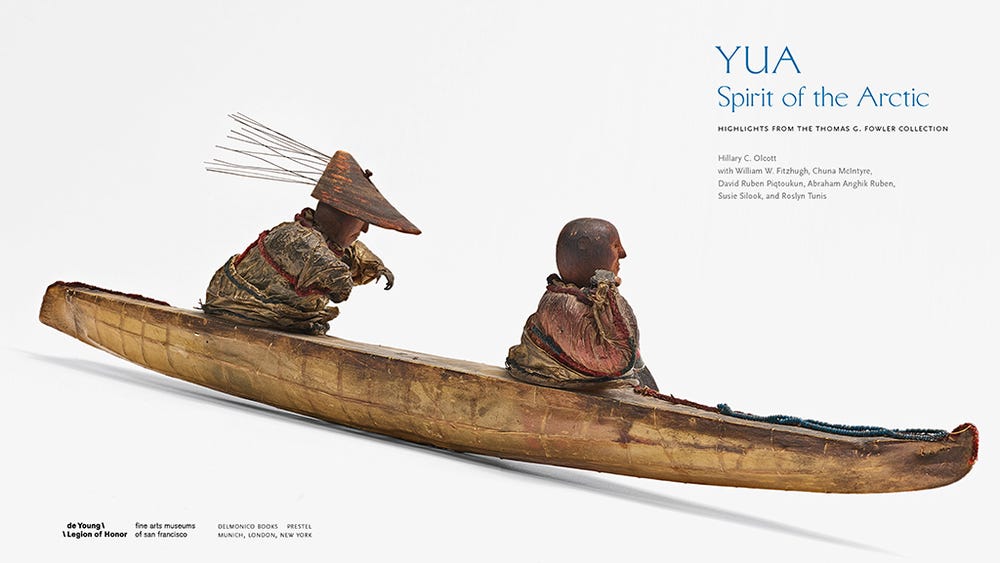Yua, Spirit of the Arctic: Eskimo and Inuit Art from the Collection of Thomas G. Fowler
Jul 23, 2009
San Francisco, June 2009—On August 28, the de Young opens a new permanent exhibition in the Art of the Americas galleries, entitled Yua, Spirit of the Arctic: Eskimo and Inuit Art from the Collection of Thomas G. Fowler. The word yua means spirit or soul. Its prominence in the title reflects the widely shared Eskimo/Inuit concept that all living things in the natural world, even inanimate objects possess a spirit or a soul that must be honored.
The outstanding artworks on view are all gifts to the museum from the Estate of the late Thomas G. Fowler (1943–2006), a multitalented artist, designer, collector and businessman. During his lifetime, he made many trips to Alaska, creating a comprehensive collection of rarity and scope that is unique in the Western United States. It was always his wish to share the collection with the widest audience possible. The collection is an excellent addition to the de Young Museum’s West Coast Native American holdings. “Not only does the Thomas G. Fowler Collection enhance our Native American holdings, it is a perfect complement to the Museum’s world-class collection of the arts of New Guinea, Africa, and the Americas,” says John E. Buchanan, Jr., director of the Fine Arts Museums of San Francisco.
The Installation
The inaugural exhibition includes nearly 100 objects from approximately 3rd century B.C. to the contemporary era, representing both the aesthetic and the utilitarian sensibility of Arctic life. Objects include figures, baskets, bowls, tools, pipes, boxes, snuff containers, snow goggles, kayak models, cribbage boards, animal carvings, dolls, and stone sculptures in a variety of materials, such as ivory, whalebone, walrus tusk, sea mammal intestine, wood, fiber, and stone.
Yua, Spirit of the Arctic contains intriguing pieces whose original uses range from ceremonial to recreational. One notable object is a model of a Kashim, or dance house, with eleven dancers and musicians performing to maintain the balance the community against the uncontrollable forces of nature and spirits that govern their survival. Another rare piece is an ornately carved, late 19th-century ivory cribbage board from Nunivak Island, detailing a large number of animals that appear to be eating each other, perhaps a stylized depiction of the life cycle.
This installation also includes a selection of pots gifted from Paul and Barbara Weiss. Over the last ten years, Paul and Barbara Weiss have traveled throughout the Southwestern United States, carefully selecting outstanding examples made by prominent Pueblo potters. The oldest pots come from the venerated pueblos of Acoma, San Ildefonso, and Hopi.
Eskimo and Inuit History
Many scholars believe the ancestors of the indigenous peoples of the North migrated to Alaska over the Bering Land Bridge more than 4,000 years ago and apparently lived in relative isolation until their first encounters with Europeans in the 16th century. In 1867, the United States purchased Alaska and whalers, fur trappers, and missionaries came to the area, bringing Western culture.
These foreign visitors purchased Inuit and Eskimo objects as souvenirs and as a result, the native people began to create varied pieces for trade with the foreigners. During the 19th century, most of the Inuit artwork was made specifically for sale or early tourist trade. Today, the practice of creating art for sale continues.
Thomas G. Fowler
Thomas G. Fowler, from Stamford, Connecticut, was more than an avid collector; he was an artist, designer, illustrator, outdoorsman, and traveler. He had a lifetime appreciation for the Far North and embraced the Inuit aesthetic and culture. His collection started in the 1970s with his first piece of Inuit art, and led to the founding of the Inua Gallery and the 400-piece large Thomas G. Fowler Collection. In 1975, he started a major graphic design firm in Connecticut, Tom Fowler, Inc; which in 2008 updated its name to TFI Envision, Inc.
Organization
Yua, Spirit of the Arctic: Eskimo and Inuit Art from the Collection of Thomas G. Fowler is organized by the Fine Arts Museums of San Francisco in close consultation with Chuna McIntyre, a Yup’ik artist and performer born in Alaska, and Roslyn Tunis, a noted authority and independent curator. The presenting curator is Kathleen Berrin, FAMSF curator-in-charge of Africa, Oceania, and the Americas.
Programs
On August 28, Friday Nights at the de Young celebrates the opening night of Yua, Spirit of the Arctic with a special lecture by celebrated, contemporary Siberian Yupik Eskimo artist, Susie Silook, 7–8 pm in the Koret Auditorium. Museum admission is not required for this program.
On Thursday, October 1, at 10 am, there will be an art history lectured entitled Inuit Art from the Thomas G. Fowler Collection by Roslyn Tunis, independent curator and consultant, in the Legion of Honor’s Florence Gould Theater. Admission is $4 for the public and $3 for FAMSF members.
de Young Visitor Information
The de Young, designed by Herzog & de Meuron and located in Golden Gate Park, showcases American art from the 17th through the 21st centuries, international contemporary art, textiles, and costumes, and art from the Americas, the Pacific, and Africa.
Golden Gate Park, 50 Hagiwara Tea Garden Drive
Hours:
Tuesday–Thursday, Saturday and Sunday: 9:30 am–5:15 pm. Friday: 9:30 am–8:45 pm. Closed on Monday.
Café: 9:30 am–4:30 pm
Museum Store: 9:30 am–5:00 pm
Admission:
$10 adults, $7 seniors, $6 youths 13–17 and students with a college I.D., Members and children under 12 are free.
The first Tuesday of every month is free.
The de Young is accessible to wheelchair users. For information, contact the ADA Coordinator: 415.750.7645 (voice)
